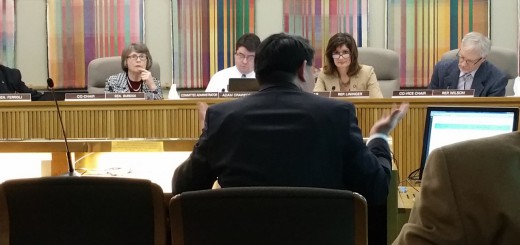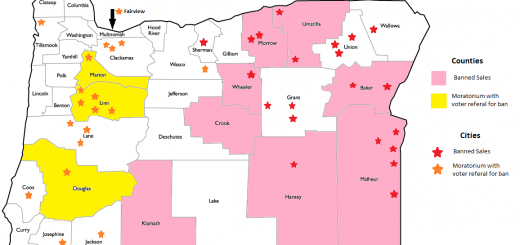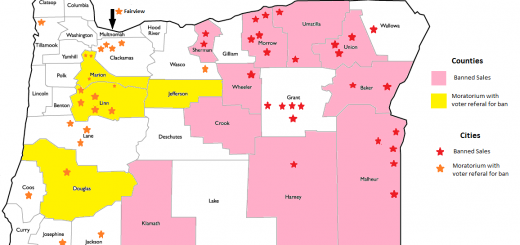On Monday, June 1st, the Joint Committee on M91 held a public hearing on the draft of the dash 8 amendment to HB 3400. This 116-page comprehensive amendment combined a variety of bills into one working product.
Legislative Counsel Mark Mayer introduced the draft amendment by addressing 11 policy points covered in the draft language:
- Page 17, Section 12 is first instance of a change that applies to all license holders; the residency requirement was reduced to one year (down from four, then two, now one) and only applies to applicants (instead of all individuals on application).
- Page 19, Section 13 deals with canopy limits, and allows the limits to be addressed by rule with OLCC consideration of equivalent production from indoor and outdoor gardens, a tiered system where good actors are rewarded, and where market demand is a factor in determining limits.
- Page 34, language change for licensing and enforcement specialists, which OLCC asked for. Also, in subsection 2, these enforcement specialists cannot be sworn in as federal law enforcement while working on state marijuana enforcement tasks and cannot carry a firearm.
- Page 37, Section 35 is land use language that still needs updated with forthcoming changes.
- Page 75 is testing language, where OLCC will do enforcement and licensing and OHA will do accreditation of labs and rule-making.
- Page 82 is packaging, labeling and dosage language, where the split in powers is OHA doing labeling rules and dosage standards and OLCC will be doing packaging rules.
- Page 89 is research certification, where “license” terminology was removed because some “license” language would not apply to research, and replaced with “certification” but applying appropriate “license” regulations. On page 90, subsection 6, the commission can exempt research certificates from license requirements, if desired.
- Page 91 is brand new language regarding edibles, intending to make edibles subject to the normal food standards consumers expect; marijuana in edibles is not an additive or adulterant and particular unnecessary standards are not applied.
- Page 92 is an “opt-in” for medical growers to sell into the recreational market; growers can choose (but are not required) to participate in M91 system subject to rules by OLCC and OHA. On page 93, OLCC may waive rules that are inapplicable.
- Page 94, Sections 115 and 116 deal with water and energy usage; Section 115 is for reporting on water source and usage and Section 116 applies to operations using grow lights, indoor gardens, to require energy plans be submitted to OLCC to ensure energy efficient operations. Pages 96-97 identify energy goals.
- Overall crime reductions
Rob Patridge, the Chair of the OLCC testified on what the ad hoc group had put together, and stated that overall the dash 8 amendment looked good but that the ad hoc committee would meet on Tuesday to look through the language to get a final product for drafters. He said that the OLCC had not contemplated an early start, as proposed by the dash 3 amendment.
Co-Chair Burdick asked about the intent behind the OLCC ability to waive rules, and Patridge explained that the intent is to bring growers into the recreational market “where they currently sit.” Burdick wanted to know if this ability to waive requirements would apply to recreational licensees as well, or only to medical and Patridge clarified that the intent was for it to apply only to medical licensees.
Senator Prozanski asked about the intent behind the reduction in residency requirements from 2 years down to 1 year, and Patridge said that the change did not come from OLCC. OLCC Executive Director Steve Marks said that there was some discussion around the residency requirements in their ad hoc meetings, but that the OLCC was not weighing in on the subject. Representative Lininger said that the ad hoc committee consensus seemed to be that 1 year makes sense but should only apply to applicants; investors should not be subject to residency requirements, but instead have background checks. Co-Chair Burdick said she was surprised, but pleased by the change in residency requirements. She said that the need for capital was so high, and that limiting the size of grows and applying background checks will give Oregon residents a leg up, legally.
Representative Buckley questioned the change on page 19 that applies canopy limits to both indoor and outdoor grows, where outdoor limits were previously measured by plant limits. Patridge said that the consensus from the ad hoc group was that OLCC could manage canopy limits by rule so long as the harvest was equitable. Buckley said he was interested in hearing Seth Crawford’s thoughts on what that level should be.
Representative Wilson referred to page 94, Sections 115 and 116, wondering about the source of the language. He questioned the experience of the Department of Energy on these limits, and suggested that the “fee” was actually a “fine” on indoor gardens; he questioned the basis for the “fee”. Patridge said that these Sections were not a consensus item and that Representative Buckley could probably elaborate. Representative Buckley explained that consumption rates for energy are distributed across geographical regions, so if the use was driven up by a particular entity, the rates would go up for all customers in that area. He said that the intent was to protect “your bill”, and that similar concepts were implemented in Arcadia, California when local ordinances drove cultivation indoors and energy uses rose dramatically. He also said that Colorado was moving towards similar measures.
Anthony Taylor of Compassionate Oregon testified that he was pleased with most things in the dash 8 amendment and that as a patient advocate, he and the patients he represents were becoming more trusting of OLCC oversight. Geoff Sugarman from the Oregon Cannabis PAC testified that the support the dash 8 amendment, including limits, edibles and the opt-in language for medical growers.
Jonathon Manten of the Oregon Sungrowers Guild testified that they had some disagreements, but were mostly in agreement with the dash 8 amendment. They would like to see more limits on inspection authority of OLCC on small family farms, where the authority would only extend to areas used for business activities and not private homes. They would also like to see ecologically friendly packaging, the 2-year residency requirement reinstated, and a potential allowance for small scale farmers who may desire to sell excess marijuana into the recreational marijuana market one or two times per year to not have the required “OLCC hoops”.
Don Morse of the Oregon Cannabis Business Council testified that he was a member of the ad hoc committee and that the industry supported the compromises, but felt that patients should be clearly exempted from taxation, whether buying medical marijuana or recreational marijuana.
John Sajo of the Umpqua Cannabis Association testified that language that had floated that would allow personal home cultivation within 1000 feet of a school needed to be included, if it wasn’t already. He also recommended that possession limits be increased above the current 8 ounces, else home cultivation would immediately result in becoming a felon simply by harvesting the legal plants. Since that activity resulted in becoming a felon, individuals would be incentivized to sell into the black market to reduce their supply. He finally suggested a progressive licensing fee structure that would favor small businesses and family farms determined by gross revenue; he said that a thousand small farms were better, but bigger farms could participate by paying their share. He also felt that progressive license fees might help with the local opt-out concerns if a portion of fees were put towards localities.
Geoff Sugarman of the Oregon Growers PAC testified that he had concerns with Section 116’s energy provisions that charged a fee. He said cannabis producers already have more requirements than other businesses, including increased licenses and oversight. Section 116 would be difficult to implement and appears to require a fee even if the producer is under the estimates of usage. He stated that data centers and other major energy consumers were not subject to similar fees, and that the fees were difficult to understand and wouldn’t help bring people into the legal marketplace. He said more time was necessary on water and energy usage and therefore they oppose Section 116. Representative Buckley explained that it was not intended to punish producers, but to set some standards to minimize impact. He said he was happy to further discuss the issues surrounding energy use.
Representative Helm questioned Sajo’s position on increasing possession limits for home cultivation, questioning if allowing co-ops to hold an individual’s harvest might alleviate the concerns with possession limits. Sajo responded that it was possible, but the combination of bills was likely to incentivize OMMP growers to hold the harvest of a private grower and was likely to have unintended consequences. Representative Wilson stated that the progressive license fees suggested by Sajo were comparable to how the FCC handles radio licenses.
Senator Prozanski questioned if the reduced residency requirement of one-year was from the ad hoc committee, and Sugarman said that there was broad support on excluding investors from the residency requirements and a broad array of positions on residency requirements, including some who wanted no residency requirements. He said that there was no consensus on this issue.
Todd Dalatto testified that there were concerns with the definitions, which he elaborated on in his written testimony. He explained that concentrates were typically a result of removing water to further concentrate a substance, but this use was actually the exact opposite, by infusing cannabis into oils or other products. He explained that the terminology of hydrocarbons would be better coined alkalines, because hydrocarbons included some substances that shouldn’t be and failed to include others that should be included. He also spoke regarding the residency requirement indicating that most people interested in the industry either had money but lacked knowledge, or had knowledge but lacked money. He said that 51% of investment equity should come from Oregon, but allow the other 49% to come from elsewhere. He also said that the canopy limits were preferable to plant limits, and that he supported research and nursery licenses. Finally, he recommended that instead of strict limits on energy usage, consider research and incentives to encourage efficient production or to participate in the research.
Lisa Naito of Phylos Bioscience testified that the testing and lab standards were good. She also spoke about the change in the dash 8 amendment for nursery licensing to fall under producer licenses, to resolve earlier conflicts with nursery licenses in other agricultural products, but with different limits since the product is immature plants and seeds. She recommended that research and lab testing be moved up to an earlier date.
Seth Crawford for Oregon State University testified that the rec market demand was between 30,000-60,000 pounds, and he wondered what the canopy sizes to fulfill that demand might look like. He said that the existing level of demand could be fulfilled by only seven 5000 square foot greenhouses in Southern Oregon, or 147 1000 square foot gardens. He also spoke about the “brand” of Oregon cannabis, known as pure, natural, organic and sungrown. He said that half of the production should not be indoor, and questioned what the term indoor actually meant. He said that greenhouses without a foundation were likely to be deemed outdoor, and that while these issues were fine to handle with rule, we should be “careful”. He said that 5000 square foot canopies will push prices down dramatically and only those with capital will be able to weather the storm for the first 2-4 years while everyone else will be pushed out.
When Co-Chair Burdick requested more specific numbers, Crawford said he would provide the committee with some estimates, but that his estimates were that recreational users consume 30,000-60,000 pounds per year and that was able to be fulfilled in a small number of sites. He said that production quotas were a “fantastic idea” and if quotas were in place, canopies could be unlimited. Representative Buckley asked what production quotas would look like, and Crawford said that a licensee would be given a production quota of a certain amount, for example 500 pounds, and could determine the most economic way to accomplish that. Senator Kruse suggested that the problem with the quotas was that other farmers could dispose of excess anyway they desired, but not so with marijuana.
Senator Prozanski asked what the consumption rate for medical users was, and suggested that the estimates for recreational users was pretty low. Crawford answered that the 80/20 rule was the best measurement, like other substances: 20% of users consume 80% of the supply. He said that 90-95% of the OMMP is comprised of “super-users” who would fall into the 20% who use the most marijuana, leaving only about 8% of super-users in the recreational market. While average users of marijuana might only consume 1.2 grams per month, according to Crawford, super-users might consume as much as 60-80 grams.
Co-Chair Burdick questioned the market demand for medical marijuana, and Crawford said the numbers weren’t immediately available, but approximately 80,000-90,000 pounds. He suggested that the movement from medical marijuana production to recreational production might result in shortfalls, and that a production quota would allow farmers to be profitable and possibly divert excess to low income patients.
Patridge testified to a few issues that were outside the purview of the OLCC to comment on that came out of the ad hoc committee meetings, specifically:
- Land use compatibility statements, and time place and manner restrictions.
- Tax rates.
- No residency requirements for investors, but required background checks.
- Determining how to handle minors in licensed establishments, especially family farms where children might be present and what the role of DHS and child welfare would be in those situations.
He also testified on the proposed early start language in both the dash 8 amendment in Section 129, which does not involve the OLCC, and the dash 3 amendment, which includes the OLCC. He said that the OLCC wants to get this right, and that Washington and Colorado each had about 1-1/2 years to implement rules and regulations and that Colorado even had already instituted the seed-to-sale tracking previously for marijuana. He suggested that the rules and regulations take time to develop and that rushing to implement the sales will prevent the OLCC from effectively implementing the permanent retail sales under M91. He said that the OLCC had a lack of sufficient staffing already, and that they were further concerned about what impact there would be on patients, if the supply would be adequate. He said that localities wouldn’t have time to offer input and implement their opt-out and that a loosely regulated market could open up both the recreational and medical programs to federal scrutiny. Overall, he said the public would benefit from a well-thought-out system.
Senator Prozanski said he felt that Section 129 in the dash 8 amendment was appropriate, since it would limit purchases to 1/4 ounce and immature plants, but that we should be careful with what is rolled out to the public without sufficient education. Senator Ferrioli agreed that the timeline was good for the well-thought-out rules but that with legalization on July 1, that the OHA should enter a memo of understanding with OLCC to offer limited products on July 1. He suggested that the tax issue was separate, but that banks can take tax payments from marijuana growers. He suggested that July 1st sales was not an “early start” but an “on-time start” and that OHA, OLCC and the Department of Revenue should be discussing this since it was a conversation point since February and not a “surprise”. He said that there was no obstacle that could not be surmounted in the time before July 1 and that the “soft start” should not interfere with the OLCC roll out of the 2016 plan for retail sales.
Senator Ferrioli also introduced a banking work group that was working with the Governor’s office, banks, credit unions, the Attorney General, Treasury and the Department of Justice to resolve the problem for marijuana businesses to enter the federal banking system. He said with 4 states with recreational marijuana and 33 with some form of medical marijuana, that there needed to be a strong effort for reclassifying marijuana out of Schedule I and a memo of understanding for entering the federal banking system.
Pete Kramer from Mercy TV concluded the testimony for the evening by estimating one outdoor plant as producing 10 pounds of marijuana while an indoor plant might produce only 1-2 ounces, up to 5 ounces if you have the heighth.
Burdick adjourned the meeting after calling for a diversity of opinion on the proposed dash 8 amendment and the upcoming dash 9 amendment that would be prepared Tuesday.
You can watch the full hearing online or download pdf’s to read the submitted testimony.






